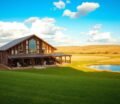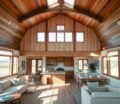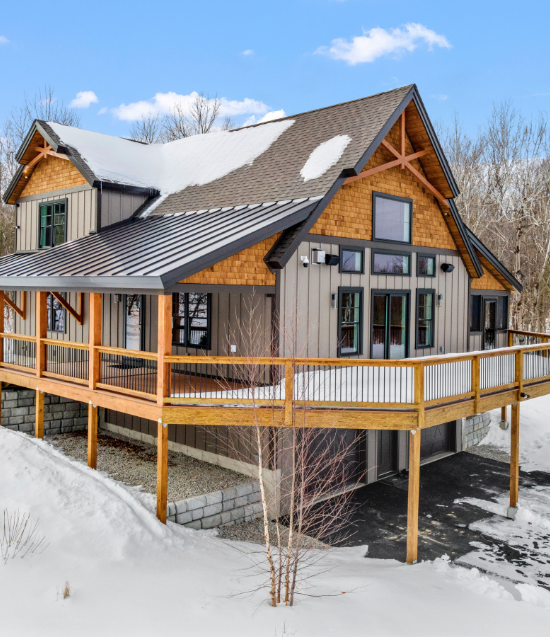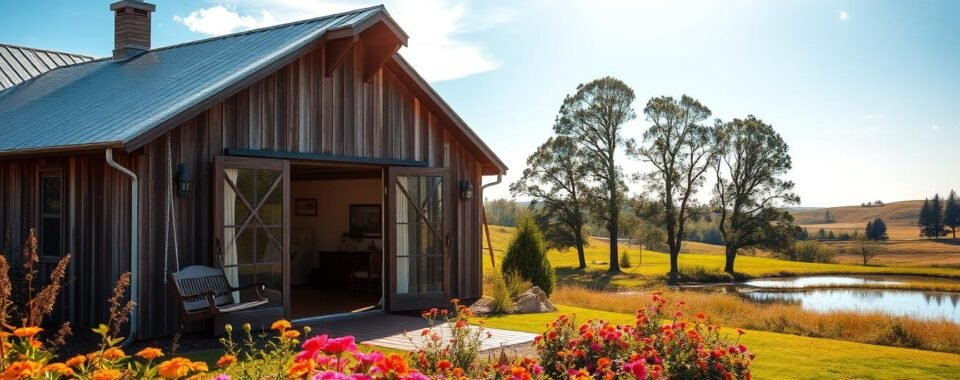

We remember our first barndominium tour vividly. It was a sunny morning in Kansas. The steel frame had turned into a cozy living room. The owners used a Buildmax kit and customized the RP-10005 Hopkins plan.
They added a utility room and wide porches for coffee. This mix of standard planning and personal touch is key to Barndominium Life.
Barndominium living is more than a trend. It’s a design movement blending rural freedom with modern building. We dive into plans that focus on open spaces, flexible layouts, and clear technical details.
This helps builders and students follow practical, technical guidance.
In this roundup, we share real-life stories, design tips, materials, financing, sustainable options, DIY projects, maintenance advice, and family planning. For direct help, email us at info@barndoplans.com or call +1-844-963-9963.
If you’re looking for a barndominium for sale, refining plans, or just exploring, we’re here. We offer the technical insight and creative spark you expect.
The Rise of Barndominiums in America
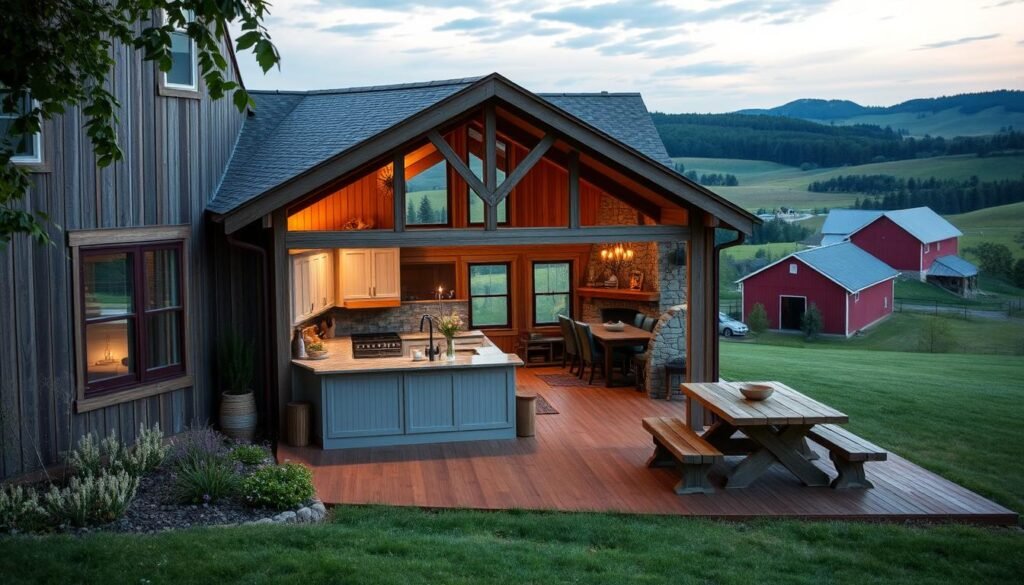
We see a big change in how people build homes in rural and suburban areas. Now, barn-style shells are being turned into modern homes. This mix of old and new offers a practical, durable option for homes that can also have workshops and open-plan living.
What is a Barndominium?
A barndominium is a home that looks like a barn on the outside but is fully finished inside. They use metal framing, vertical siding, and metal roofing. This creates big, open spaces without columns.
Building a barndominium is easier thanks to prefab steel frame kits. These kits save money on labor. Adding touches like stone accents, polished concrete floors, and vaulted wood ceilings makes the home cozy and inviting.
There are many designs to choose from. For example, the RP-10005 Hopkins plan is a 36×50 layout. It has an open-concept living area, porches, polished floors, and wood ceilings. This shows how barndominiums can be both stylish and practical.
Why Choose a Barndominium?
There are three main reasons people choose barndominiums. First, they are cost-effective. The use of steel kits and simple framing lowers the cost of building and maintaining the home.
Second, building a barndominium is faster. The prefab kits and easy assembly mean homes can be built quicker than traditional houses.
Third, barndominiums offer flexibility. Owners can customize their homes for guest suites, home offices, workshops, and large entertainment areas. This appeals to families and hobbyists who want a mix of country charm and modern living.
Benefits of Barndominium Living
Living in a barndominium has many benefits. The cost of building one is often lower than traditional homes. The average 2,400-square-foot home with basic finishes can be more affordable.
Another advantage is durability. Steel-framed barndominiums can last for decades with little upkeep. Wood-framed homes can last even longer if properly maintained.
| Feature | Typical Value | Impact |
|---|---|---|
| Cost per sq. ft. | $94–$120 | Lower-than-average initial build cost |
| Kit price range | $5,000–$70,000 | Scalable options for varied budgets |
| Example plan | RP-10005 Hopkins (36×50) | Open concept, porches, vaulted ceilings |
| Build speed | Faster with prefab kits | Reduced labor time and site complexity |
| Frame longevity | Steel: ~50 years; Wood: ~100 years | Long-term durability with proper maintenance |
It’s wise to talk to experienced builders and look at industry trends. For more information and statistics, check out Barndominium Life statistics. This resource helps buyers make informed decisions about their build.
Real-Life Barndominium Stories
We share stories from owners who made their barndominiums into cozy homes. These tales show how Barndominium Life mixes country practicality with luxury. You’ll see how design choices affect daily life and long-term value.
One project had a front porch, metal roof, and stone foundation. A family added a wrap-around porch and a covered patio with an outdoor kitchen. This change made entertaining all year round and connected the home to nature.
Inspiring Transformations
A farmhouse shell was transformed with vaulted wood ceilings and a stone fireplace. Custom cabinets and granite countertops updated the kitchen. Barn doors kept the rustic feel. These ideas turned an industrial space into a cozy home.
Buildmax supplied steel frame kits, speeding up construction. This made budgets predictable and allowed for early focus on finishes and furnishings.
Unique Designs from Across the U.S.
Regional tastes influenced designs. In the Pacific Northwest, metal roofs and deep eaves handled rain. In the Midwest, stone foundations and wide porches adapted to seasons.
Some owners chose industrial minimalism with exposed steel and polished floors. Others picked rich wood tones and layered textiles. These choices show how designs fit various climates, budgets, and lifestyles.
Family Experiences and Testimonials
Families felt closer after opening up the main level. Open-plan areas became gathering spots. Mud rooms kept boots and gear organized.
Parents loved rooms that served as offices and play areas. Kids’ spaces had bunk systems and storage. These features support flexible family needs.
| Feature | Typical Finish | Benefit |
|---|---|---|
| Front porch with wooden posts | Painted or stained timber | Shade, curb appeal, outdoor living transition |
| Metal roof | Standing seam steel | Longevity, low maintenance, modern look |
| Stone foundation | Natural or cultured stone veneer | Thermal mass, visual permanence, regional authenticity |
| Covered patio with outdoor kitchen | Weatherproof counters and appliances | Extended entertaining season, indoor-outdoor flow |
| Vaulted wood ceilings | Exposed beams or tongue-and-groove | Warmth, acoustics, dramatic volume in living spaces |
| Floor-to-ceiling stone fireplace | Local stone or stacked veneer | Focal point, efficient heating, rustic elegance |
| Custom cabinetry & granite countertops | Hardwood cabinets, engineered stone | Durability, resale value, tailored storage |
| Mud room | Benches, hooks, washable flooring | Organization, reduced wear on main areas |
| Built-in bunk systems | Solid wood frames with storage | Space efficiency, kid-friendly design |
| Steel frame kit delivery | Pre-cut, labeled components | Faster erection, predictable costs, less waste |
Designing Your Dream Barndominium
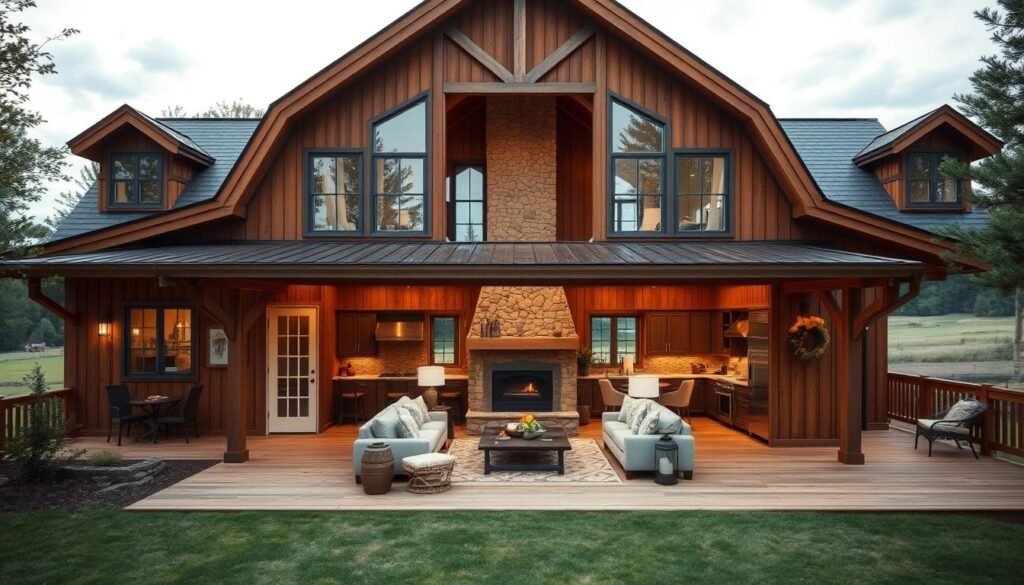
We help you make your dream home a reality. Start with a central area for living, kitchen, and dining. This layout brings in light and makes the space feel bigger. Add vaulted ceilings and big windows for more light.
Don’t forget a mudroom or utility room to keep things tidy. Covered porches are great for enjoying the outdoors. These ideas make your home comfortable and valuable.
Key Design Elements to Consider
Design your kitchen around an island. Include a farmhouse sink, stainless steel appliances, and a pull-out trash can. An integrated pantry is also a good idea, like in RP-10005.
Make sure your closets are walk-in and have dedicated mud/drop zones. Good egress paths are important for daily use. Plan wall sections and roof framing early to avoid costly changes later.
Think about how your home will stay warm or cool. Use proper roof overhangs for shade and insulation. Aim for R-20 to R-30 insulation in temperate areas and R-30 to R-40 in colder ones. Roof insulation should be R-30 to R-60 for all-year comfort.
Popular Layout Trends
Open-plan single-story homes are popular. RP-10005 is a great example at 1,800 sq ft with 3 beds and 2 baths. L-shaped kitchens and island workspaces are great for cooking and entertaining.
Flex rooms can be offices, guest suites, or hobby spaces. Lofts add extra sleeping or office space without increasing the home’s size. Attached workshops and garages are perfect for hobbyists and small businesses.
Entertainment and media rooms provide private spaces for family. These plans reflect a lifestyle that is productive, social, and adaptable.
Choosing the Right Materials
Metal framing and steel kits are fast and durable. Buildmax-style systems can cut construction time. Wood framing adds warmth and is often cheaper upfront.
Choose flooring that’s easy to maintain and comfortable. Polished concrete is durable and efficient, while hardwood is warm and easy to refinish. Stone fireplaces add beauty and thermal mass. Wood-planked ceilings soften the look of industrial interiors.
For countertops and cabinetry, go with granite and solid wood for durability and luxury. Coordinate your MEP systems with your structural choices. Full plan sets can reduce surprises and help builders meet deadlines and budgets.
| Element | Typical Option | Pros | Cons |
|---|---|---|---|
| Framing | Steel kit (Buildmax) | Durable, fast erect, low rot risk | Higher material cost, requires corrosion detailing |
| Framing | Wood | Lower initial cost, easy finish work | Higher maintenance, moisture sensitivity |
| Flooring | Polished concrete | Durable, thermal mass, low upkeep | Hard underfoot, colder without radiant heat |
| Flooring | Hardwood | Warmth, reparable, high resale appeal | Maintenance, sensitive to moisture |
| Ceilings | Wood-planked vaulted | Visual warmth, acoustic benefits | Cost and maintenance for finishes |
| Energy Strategy | Insulation & renewable planning | Lower operating costs, future-proof | Higher up-front investment, requires coordination |
Plan for a 10–20% contingency for custom projects to handle price changes. For detailed guidance on customizing your barndominium plans, check out barndominium plans. This resource explains the process from start to finish, usually taking 6–16 weeks.
Work closely with experienced builders and designers. They’ll help you make the right choices for your Barndominium Life. This includes metal versus wood framing, flooring, insulation, and renewable systems.
Barndominium vs. Traditional Homes
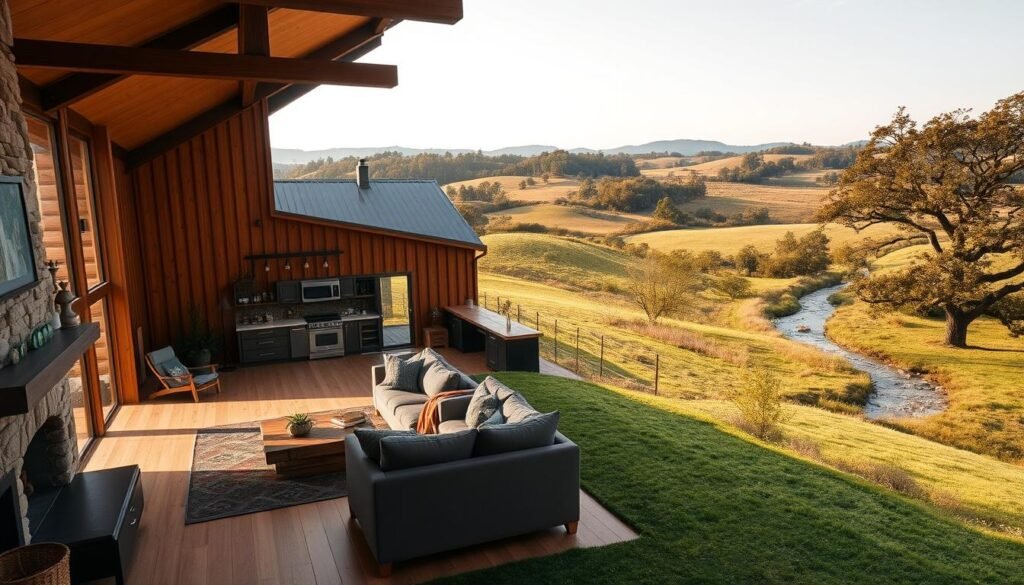
We compare common trade-offs so readers can weigh practical differences. This is between a metal-framed barndominium and a conventional wood-framed home. We aim to make costs, maintenance, and daily life clear without jargon.
Cost Comparisons
Barndominiums often cost less upfront than traditional homes. This is because metal framing and open plans use less material and labor. Prefab kits and plan-matching options from builders like Buildmax help keep costs down and prevent overbuilding.
National averages show a wide range of prices. For a deeper price breakdown, check out a resource that lists square-foot and kit prices. This way, you can match finishes to your budget.
Maintenance Considerations
Steel siding and metal roofing mean fewer routine repairs. Polished concrete floors also reduce wear and cleaning time. But, stone and wood accents need more focused upkeep.
Thermal bridging and HVAC sizing are key for durable performance in metal buildings. Detailed plan sets, like RP-10005 style specifications, help builders address insulation and mechanical routing. This avoids long-term issues.
Lifestyle Differences
Barndominium living focuses on open, flexible spaces. These are great for entertaining and multigenerational households. Large utility areas, mudrooms, and workshops support rural routines and hobbies.
Traditional homes often have more compartmentalized rooms for privacy. This layout is good for certain family dynamics. But, barndominium construction favors adaptable zones that evolve with lifestyle needs.
| Aspect | Barndominium | Traditional Home |
|---|---|---|
| Typical up-front cost | $115,000–$540,000 (kits available from $5,000) | Often higher for comparable square footage due to framing and finishes |
| Square foot cost | $110–$300 | Varies widely; commonly higher in high-end finishes |
| Major maintenance items | Metal roof, steel siding, HVAC insulation checks | Roofing, siding, trim, and foundation repairs |
| Ideal use | Open-plan living, workshops, multigenerational households | Private rooms, formal layouts, urban infill |
| Customization | High: flexible floorplans and mixed finishes | High: many finish and layout options but often costlier |
| Builders | Specialized barndominium builders and kit suppliers | General contractors and traditional home builders |
Sustainable Living in Barndominiums
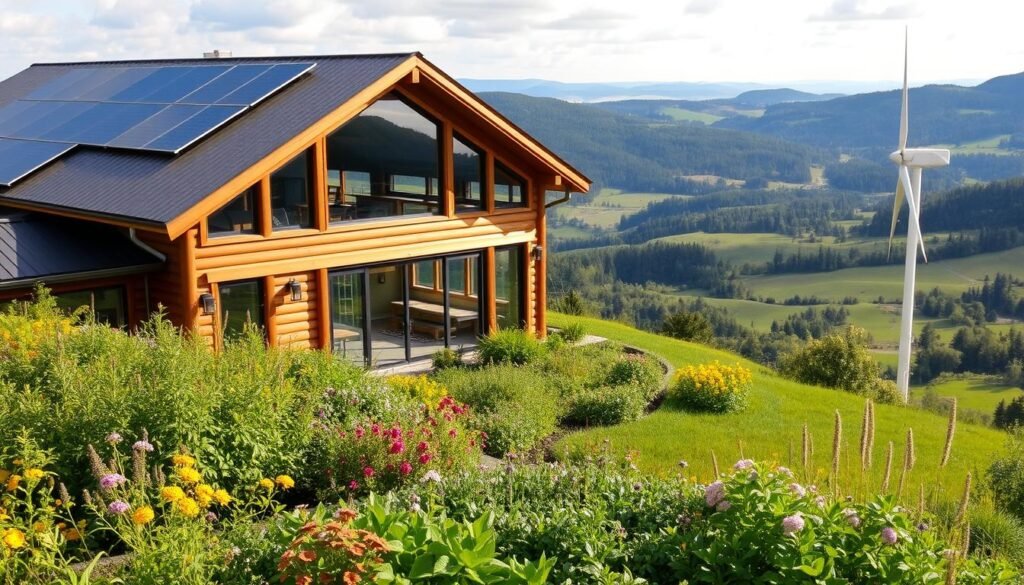
We focus on making barndominium living both practical and eco-friendly. Our methods include energy-saving systems and materials that are kind to the planet. Barndominium Life readers can learn how to cut down on costs and stay comfortable in their metal homes.
Energy Efficiency Features
Begin with top-notch insulation for metal homes: spray foam or rigid board helps keep warmth in. Match insulation with the right HVAC size to avoid waste. Plans like RP-10005 show how to size HVAC correctly.
Choose windows that save energy and design with shading in mind. Polished concrete floors help keep temperatures steady by storing and releasing heat.
Eco-Friendly Building Materials
Use reclaimed or eco-friendly wood for walls and trim to add warmth. Low-VOC finishes keep air clean and are safe for families. Stone accents are durable and easy to care for.
Steel frames are strong and can be recycled. Pair them with metal roofs for easy solar panel installation. Metal roofs are long-lasting and easy to maintain.
Sustainable Practices for Owners
Face the building south for natural light and use less west-facing windows. Collect rainwater for plants and use drip irrigation to save water. LED lights and ENERGY STAR appliances use less power.
Plan for good ventilation to prevent moisture damage. Use prefab kits and detailed plans to reduce waste and save time during construction.
Financing Your Barndominium Project
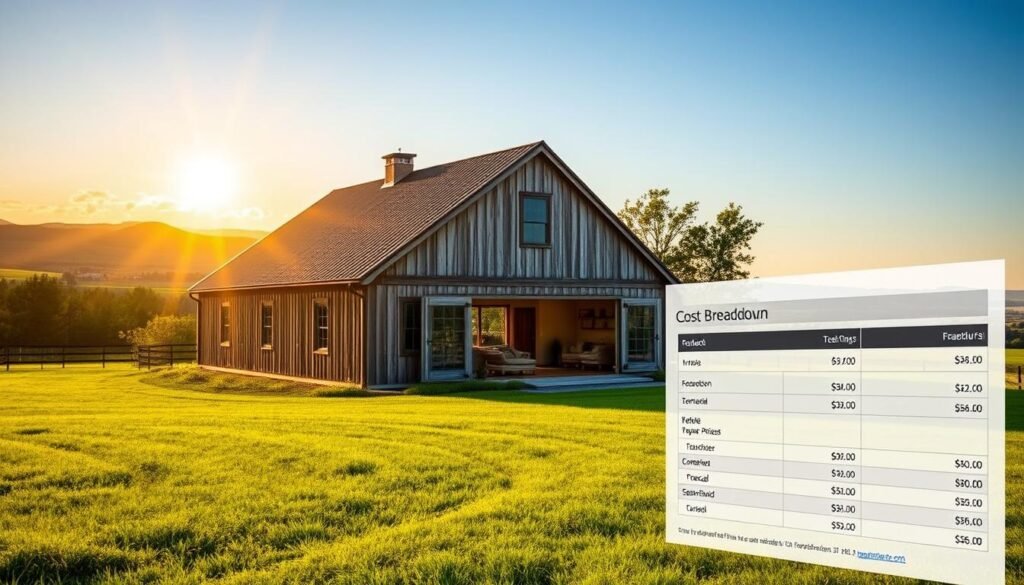
We help you understand how to fund your barndominium project. Planning early helps avoid cost surprises and keeps the project on track. Having clear plans and estimates makes it easier for lenders and builders to work together.
Understanding construction loans
Construction-to-permanent loans are popular. They turn into a mortgage once the build is done. Lenders check the build schedule, contractor’s credentials, and inspection reports before making payments.
Financing it yourself is possible if you’re doing the work. But, banks want to see you have experience and detailed plans.
Appraisals for unique homes need detailed plans. This includes foundation, framing, electrical, plumbing, and HVAC. Without these, lenders might see more risk. It’s best to provide professional drawings and a clear plan to avoid issues.
Budgeting for your build
Start by listing what you need: land, site prep, foundation, steel frame, utilities, and interior work. Don’t forget permits, inspections, and lender fees. Be cautious with finishes as prices can change.
Using floor plans with steel kits can save money and time. Buildmax-style builds combine proven plans with kits to cut down on costs and delays. Always have a 10–20% contingency for unexpected issues.
Tips for first-time homebuyers
Get a complete plan package ready for lenders: site plan, structural drawings, and detailed specs. Get quotes from builders and kit suppliers to compare prices and warranties. Lenders like to see bids when deciding on loan amounts.
Keep a reserve for unexpected costs and a realistic timeline. Talk to experienced builders to check your estimates and schedules. With good planning and a reliable team, financing and building can go smoothly.
Barndominium Location Considerations
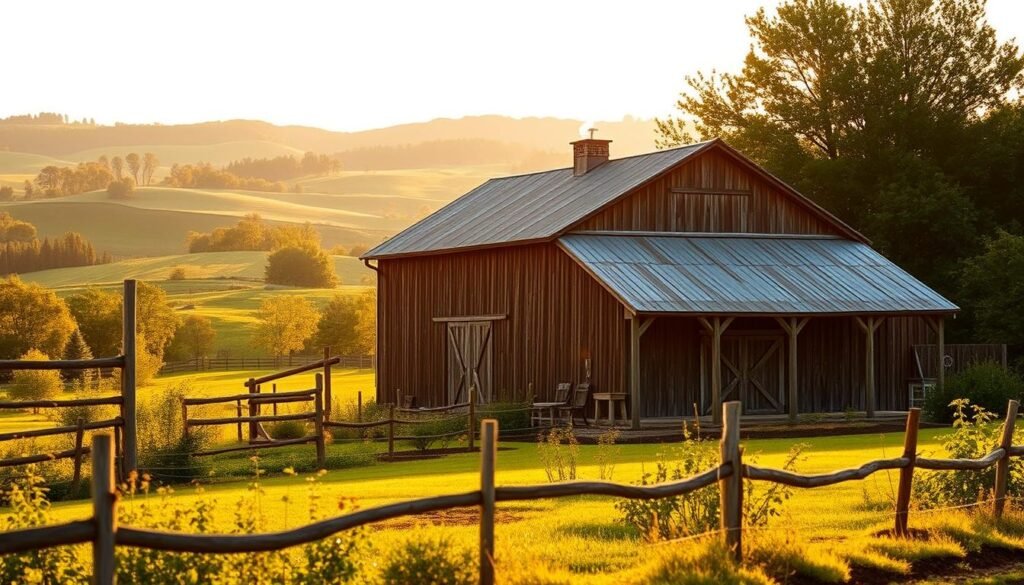
We focus on land selection, regulations, and daily access when planning a barndominium. Good placement shapes energy use, foundation needs, and the lifestyle the house supports. Below we outline practical steps to help teams, students, and builders make informed choices.
Choosing the Right Land
First, assess soil bearing capacity and grade to match your foundation and barndominium plans. A compacted, level site reduces excavation costs and long-term settling risks.
Consider lot orientation for passive solar gain: place living spaces to capture morning light and shade west-facing walls with porches. Use the RP-10005 footprint (36×50 living dimension) to plan placement of covered porches, driveways, and outdoor kitchens.
Check road access and utility proximity. A distant connection to electricity or water can add significant cost, so balance privacy with practicality when hunting barndominium for sale.
Zoning Laws and Regulations
We advise early due diligence: verify whether the parcel is zoned agricultural or residential and confirm setback requirements. Some municipalities treat metal residential buildings differently, which affects permits and inspections.
Speak with local planning departments and experienced barndominium builders to smooth permitting. They can flag issues such as floodplain restrictions, septic permits, or HOA covenants before you commit to a lot.
For permit guidance and common pitfalls, review practical tips on mistakes to avoid when building your barndominium by visiting this resource: Barndominium Life building tips.
Accessibility and Amenities
Evaluate proximity to emergency services, schools, and grocery stores. Long rural drive times can be charming for outdoor living but add complexity for daily commutes and deliveries.
Check broadband availability if remote work is part of your plan. Reliable internet often ranks with power and water in importance for modern barndominium living.
We recommend planning outdoor features—wrap-around porches, covered patios, built-in kitchens—so they fit the lot and maintain room for a driveway and future expansions. Partner with skilled barndominium builders who understand site layout and can adapt barndominium plans to both rural parcels and semi-rural properties.
DIY Barndominium Projects
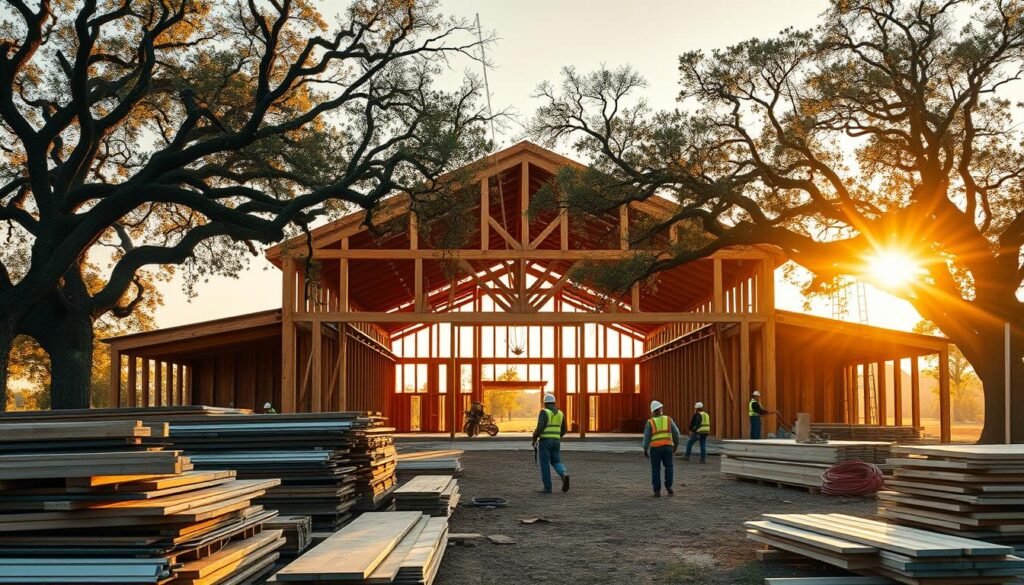
We love getting our hands dirty and planning carefully for barndominium projects. Having a solid plan helps keep costs down and schedules on track. Using prefab steel frames, like Buildmax, can cut down on construction time.
Having detailed plans, like RP-10005, makes it easier to frame the foundation and roof.
Building Your Own Barndominium
DIY projects are perfect for those with experience who know their limits. Always use certified plans and get the necessary permits. For electrical, plumbing, and HVAC work, hire licensed pros to ensure everything meets code.
Begin with a detailed checklist based on your plans. Work in phases: start with the foundation, then the shell, systems, and finishes last. This approach helps avoid mistakes and keeps subcontractors on schedule.
DIY Decor Ideas
Adding reclaimed wood planking can warm up your barndominium’s interior. Use it on ceilings or accent walls for a cozy farmhouse vibe.
Building a custom kitchen island with a butcher-block or granite top is a great DIY project. Simple joinery and quality fasteners ensure it’s sturdy for everyday use.
Barn-style sliding doors are stylish and save space. They come as kits from brands like Johnson Hardware and fit well with rustic-modern designs.
For built-in storage and bunks, use plywood, solid pine trim, and marine-grade fasteners. This combo is durable for a rural setting.
Tips for Successful DIY Upgrades
Always double-check your measurements from the official floor plan before cutting materials. Small mistakes can add up in finished spaces.
Upgrade in phases to manage your budget and time. Start with the most impactful, yet affordable, changes. Polished concrete floors and sealed wood trims are great for withstanding rural conditions.
Choose materials that fit your needs: sealed concrete for mudrooms and EPDM or metal roofing for longevity. Work with pros for system installations to avoid code problems.
Keep a build log and photo record. It’s useful for warranties, resale, and troubleshooting later on.
Outdoor Living Spaces in Barndominiums
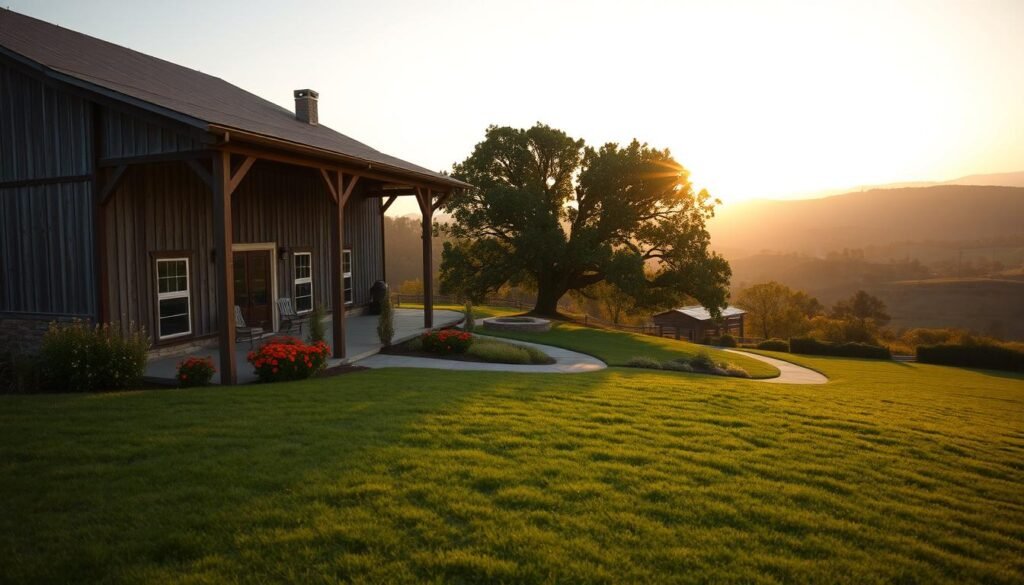
We see outdoor rooms as part of the home. They change how we live, entertain, and enjoy nature. Good outdoor design makes our homes more comfortable and valuable.
Creating Functional Outdoor Areas
Use covered patios and big porches for outdoor fun all year. Add roof overhangs to keep seats and doors dry. Outdoor kitchens, like in RP-10005 plans, make porches perfect for cooking.
Choose strong surfaces like concrete or composite decking for easy upkeep. Place lights, outlets, and gas lines where you’ll cook and hang out. These details make your barndominium better and more useful.
Landscaping Ideas for Country Homes
Go for native plants for easy-care beds that fit your area’s soil and weather. Group plants to frame windows and porch views. This makes your home look great and saves water and work.
Gravel driveways are good for country homes and help with water runoff. Divide your yard into areas for veggies, play, and parties. Each area adds a purpose to your outdoor space.
Utilizing Space Efficiently
Make transitions smooth with big doors and matching floors. Store tools and gear in a utility room or workshop. This keeps your deck clean and safe.
Turn porches and patios into seasonal hangouts. Add weatherproof furniture and fans for comfort. These choices show smart design and make your Barndominium Life better.
Barndominium Maintenance Tips
We help owners keep their barndominiums in top shape. This includes regular maintenance routines to protect value and comfort. We provide seasonal checklists, common repairs, and long-term care tips.
Seasonal Care for Your Home
Spring and fall are the best times for inspections. Check the roof and siding for corrosion, loose fasteners, or seam issues. Also, clear gutters and roof overhangs to avoid water damage and ice dams.
Before summer and winter, service your HVAC system. Change filters, check refrigerant, and test heat exchange components. Seal concrete floors or masonry joints to prevent moisture migration.
Common Repairs and Solutions
Thermal bridging is a common issue in metal-framed barndominiums. Use continuous insulation or thermal breaks to reduce cold spots and condensation. For settling cracks, review the foundation plan and consult a structural engineer if cracks are wide.
Wood accent features need regular care. Re-stain and apply a penetrating sealer every few years. Also, tighten or replace fasteners on trim and porch supports to ensure secure connections. Keep repair records for future service calls.
Tips for Longevity
Follow the manufacturer’s guidance for metal panels, sealants, and fasteners to keep warranties valid. Maintain a steady humidity level inside to protect wood ceiling planking and doors. Aim for 35–50% relative humidity year-round.
Set a regular service schedule for mechanical systems like HVAC, water heaters, and backup generators. Preserve exterior stone foundation and porch supports by repointing mortar joints and ensuring good drainage away from footings.
We recommend a maintenance plan that includes seasonal checks, timely repairs, and preventive schedules. These practices help extend your barndominium’s lifespan. They also support trusted relationships with builders during upgrades or repairs, making every chapter of Barndominium Life rewarding.
Adapting Barndominiums for Family Needs
We design family-focused spaces by mixing open areas with private spots. This keeps Barndominium Life both fun and useful. Start with plans that have lots of bedrooms, like the RP-10005 with 3 bedrooms and 2 bathrooms. Add bunk rooms or built-in furniture for kids to save space.
Features for rural living are a must. Think about a mudroom or utility area for dirt and gear. A big kitchen island is great for meals and homework. Use hallways, sliding doors, and a master suite with a walk-in closet and en-suite bath for privacy.
Planning for growth is important for long-term value. Work with builders to include space for future additions. This could be porches, garages, or workshops. Keep all plans and details handy for easy expansions and remodels as the family grows.
